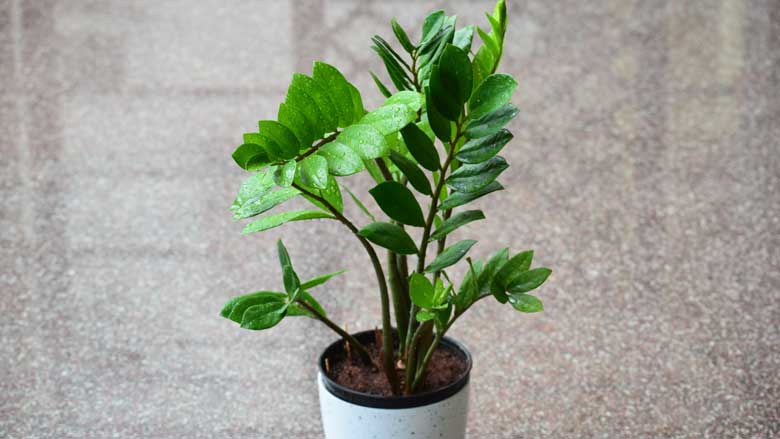When it comes to watering your plants, there can be a lot of confusion about how often you should water them and what the right amount of water is.
Different plants have different watering needs, and even the same plant will need different amounts of water depending on the time of year, the temperature, and the humidity.
One plant that is particularly finicky about watering is the ZZ plant (Zamioculcas zamiifolia).
This tropical plant is native to Africa and is known for its tough, waxy leaves that can store water for long periods.
The ZZ plant is especially sensitive to overwatering, so it’s essential to know how much water you should give it and how often you should do so.
How Often To Water a ZZ Plant
ZZ plants are known for their tough, drought-resistant nature. However, this doesn’t mean that they never need water.
Regular watering is essential to keeping your ZZ plant healthy.
The watering frequency will vary depending on the time of year, the climate, your home’s temperature, the soil type, and the amount of sunlight your plant receives.
When the outdoor temperatures are warm, it is important to keep an eye on your ZZ plant and water it every week or so, as the outdoor environment can be much hotter and drier than the indoor environment it usually receives.
In cooler weather, it can survive on a less frequent watering schedule.
In general, you should water your ZZ plant when the top inch of soil is dry.
To check the moisture level, insert your finger into the soil. If it feels dry to the touch, it’s time to water.
When you water your plants, you should use room-temperature water and thoroughly soak the potting soil until it is completely wet.
Frequent watering is especially important if you are growing your plant in a pot with drainage holes, as the ZZ plant can be prone to root rot if they don’t get enough water.
Regular watering allows your ZZ plant to thrive for years and bring beauty to your home.
Summer ZZ Plant Watering Guidelines
Your ZZ plant will need to be watered more frequently than in other seasons in the summertime.
The heat and dryness of summer can cause the soil to dry out quickly, so you should check on your plant regularly to see if it needs water.
In general, you should water your ZZ plant when the top inch of soil is dry.
To check the moisture level, insert your finger into the soil. If it feels dry to the touch, it’s time to water. This may mean watering your plant every week or so in hot summers.
Make sure to thoroughly soak the soil when you water your plants in summer, and be sure to empty any excess water from the drainage tray so that your plant does not become prone to root rot.
To help retain the soil moisture, you can place a layer of mulch over the top of your plant.
However, you should avoid overwatering your ZZ plant in summer, as this can cause soggy roots and lead to root rot.
With regular watering and some care and attention, your ZZ plant will thrive in summer and look beautiful all season long.
Winter ZZ Plant Watering Guidelines
In winter, the ZZ plant will need less water than in summer.
The plant has entered a dormant state by winter and is not actively growing.
As a result, it will need less water to prevent it from drying out.
However, it is still important to check the moisture levels regularly and water the plant when the soil feels dry.
ZZ plants are tolerant of both drought and floods, but they prefer to have moist soil.
Too much or too little water can lead to problems such as leaf drop or root rot.
Generally, it is best to err on the side of underwatering during winter.
By doing so, you can help to prevent your ZZ plant from suffering any damage.
Your ZZ plant will remain healthy and beautiful all winter with proper care and attention.
How Do You Know When a ZZ Plant Needs Water
One of the best ways to know when a ZZ plant needs water is to check the moisture levels in the soil.
Simply stick your finger into the soil and feel if it’s dry or wet.
If the soil feels dry to the touch, it’s time to water. If the soil is still moist, you can wait a little longer before watering.
Generally, it’s best to water your ZZ plant when the top inch of soil is dry.
You can also check for any signs of under or overwatering.
If you notice any signs of under or overwatering, it’s important to act quickly and address the issue before it becomes a problem.
What Does an Overwatered ZZ Plant Look Like
When it comes to watering your plants, it is always better to err on the side of too little rather than too much.
Overwatering your plants can lead to several problems, including root rot, leaf drop, and fungal growth.
So, what does an overwatered ZZ plant look like?
The most obvious sign of overwatering is wilting leaves.
If your plant’s leaves are drooping or yellowing, it is probably getting too much water.
You may also see brown or black spots on the leaves, which is another sign of overwatering.
If you think your plant is overwatered, the best course of action is to stop watering it for a few days and see if the leaves recover.
If the soil is soggy and the plant is not recovering, you should check to see if the pot has a drainage hole at the bottom to allow excess water to escape; if not, you should repot the plant in a pot with a drainage hole to help it recover.
Following a regular watering schedule and paying attention to your plant’s needs can help prevent overwatering and keep your ZZ plant healthy and beautiful.
What Does an Underwatered ZZ Plant Look Like
Just as too much water can be detrimental to your plant, the lack of enough water can also cause problems.
If a plant is not given enough water, it can suffer from dehydration and wilting, but if it is neglected and not given any water at all, it can suffer from malnutrition, stunted growth, and eventually death.
An underwatered ZZ plant will often have dry, brown leaves.
You’ll also notice that the leaves may be wilted or drooping.
The soil will feel dry to the touch and often have a crunchy texture.
If you think your plant is underwatered, the best course of action is to water it thoroughly and then wait to see if the leaves bounce back.
It’s also essential to ensure you’re not overcompensating by watering too often after an initial drought.
Be sure to check the soil before watering to make sure it is dry.
If the soil is still moist, wait a few days and check again.
Allow your plant to dry out between waterings to prevent root rot.
It’s important to be patient and only water when the plant truly needs it.
How Much Water Does a ZZ Plant Need
The ZZ plant (Zamioculcas zamiifolia) is a popular indoor plant known for its low-maintenance care requirements.
If neglected, the ZZ plant can suffer from yellowing leaves, stunted growth, and root rot, so it is important to provide it with the proper care and attention it needs to thrive.
While the plant tolerates low light conditions and infrequent watering, it is important to understand how much water your plant needs.
The amount of water a ZZ plant needs varies depending on several factors, as the size and type of pot, the type of soil, the humidity level of the room, and the time of year.
Most ZZ plants generally need about 1 inch of water per week.
However, when the plant is dormant during the winter months, it will need less water.
When watering your ZZ plant, be sure to check the soil first. If the top inch of soil is dry to the touch, it’s time to water.
Water thoroughly until the water runs out of the soil and into the plant’s container.
Make sure to pour any excess water out of the drainage tray at the bottom of your pot, as you don’t want your plant to sit in a pool of water.
If it seems like your plant is always dry and thirsty, you may need to move it to a new location that receives bright indirect light or add a humidity tray beneath the pot.
With a little bit of care and attention, you can keep your ZZ plant healthy and hydrated.
How Long Can a ZZ Plant Go Without Water
While the ZZ plant tolerates low light and infrequent watering, it is important to understand how long your plant can go without water.
The amount of time a ZZ plant can go without water varies depending on the size and type of pot, the type of soil, the humidity level of the room, and the time of year.
In general, ZZ plants can go about 2-3 weeks without water.
As temperatures begin to fall in autumn, it is important to reduce the amount of water given to your plants, allowing them to go about 2-3 weeks without water. This will give them the opportunity to enter their dormant state in preparation for winter, when they will need even less water.
In the spring, the plant will need to be watered more frequently as it enters its active growth mode, and the frequency of watering should be increased further during the summer months.
When a plant goes without water for too long, it will show some signs of distress.
The ZZ plant’s leaves may turn yellow or brown and begin to wilt, the soil will feel dry to the touch, and you may notice a crunchy texture in the dirt.
If you think your plant is going without water for too long, it’s important to take action immediately. Water thoroughly and then wait to see if the leaves bounce back. If you catch it early enough, you may be able to save your plant from permanent damage.
You may need to repot your plant in fresh soil if you notice any other signs of distress, such as spots on the leaves or slimy white growth on the roots.
If you neglect to provide your ZZ plant with the proper care and attention it needs, you may find that it begins to suffer from wilting leaves, brown spots, and root rot, ultimately leading to its demise.
Proper Techniques for Watering ZZ Plants
The ZZ plant (Zamioculcas zamiifolia) is a popular houseplant known for its low-maintenance care requirements.
One of the most important aspects of caring for this plant is learning how to water it correctly.
When it comes to watering a ZZ plant, there are a few things you need to keep in mind.
First, checking the soil before watering is essential to ensure it is dry.
If the soil is still moist, wait a few days and check again.
Allow your plant to dry out between waterings to prevent root rot.
Use a pot with drainage holes to prevent your plant from sitting in water.
Using a watering can, thoroughly water your plant, making sure to give it enough moisture so that it runs out of the drainage hole, ensuring that your plant is properly hydrated.
It’s also essential to use a well-draining potting soil mix when growing a ZZ plant to ensure the roots don’t become waterlogged.
Adding a layer of gravel to the bottom of the pot can also help with drainage.
You can keep your ZZ plant healthy and hydrated with care and attention.
Just check the soil before watering and water thoroughly when needed.
Final Thoughts
ZZ plant care is relatively simple and easy to do.
Houseplants, such as the ZZ plant, are a great way to bring life and color into your house, and with proper care, they can thrive and bring joy for years to come.
One of the most important things to keep in mind is how often to water your plant.
Watering too frequently will cause root rot, while not watering enough will cause the leaves to turn brown and drop off.
The key is finding a happy medium that works for your plant.
In general, ZZ plants need to be watered about once a week. If the soil feels dry and crumbly, it’s time to water again. However, you can also judge whether your plant needs more water by checking its foliage.
Stick to it as closely as possible once you’ve established a watering schedule that works for your plant.
ZZ plants are tough and resilient, but they can still suffer from drought stress if they’re not given enough water regularly.
If it seems like your plant is always dry and thirsty, you may need to move it to a new location that receives bright indirect light or add a humidity tray beneath the pot.
Gardening is a great way to add a touch of beauty and life to your home, and with a little bit of effort, you can create a lush and vibrant garden that is home to your ZZ plant, providing it with the necessary nutrients and hydration it needs to thrive.







